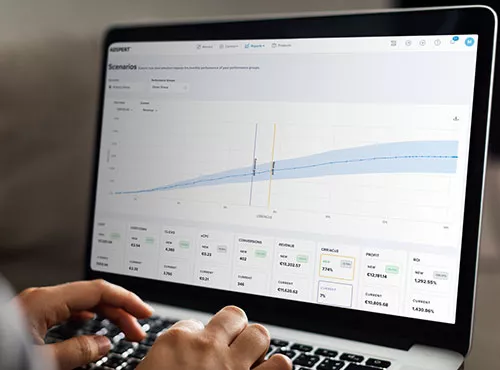On average, sponsored products on eCommerce platforms see 2x more sales than non-sponsored products. With its eBay Promoted Listings Portfolio, eBay offers sellers different advertising solutions to increase their listings’ visibility and reach by ensuring they are shown to more potential buyers.
1. Promoted Listings Standard vs. Promoted Listings Advanced
eBay introduced Promoted Listings Advanced towards the end of 2021 in order to complement the original Promoted Listings Standard campaigns and to make the eBay marketplaces more competitive with other platforms that offer PPC-based marketing solutions (PPC = Pay Per Click).
eBay’s Promoted Listings Standard
Promoted Listing Standard campaigns are a great way for sellers to begin advertising on eBay. These campaigns display product listings in different placements across eBay, and sellers only pay an advertising fee when a buyer clicks on their ad and purchases the product within 30 days.
eBay’s Promoted Listings Advanced
eBay Promoted Listings Advanced uses a pay-per-click (PPC) campaign model that grants preferred access to the top slot of eBay’s search results. Sellers can bid on keywords to win the pole position in relevant search queries buyers use, while an advertising fee is charged for each click on the ad. With eBay stating that one in five purchases starts with a listing that appears at the top of the search results page, PLA campaigns seem to be a highly attractive opportunity for sellers to increase sales on eBay.
So, while both campaign types are very useful and it is beneficial for sellers to use them in parallel to increase the visibility of their products on eBay, there are some key differences:
| Promoted Listings Standard | Promoted Listings Advanced | |
| Pricing Model | Pay-per-Sale (sellers pay a fixed fee when a purchase takes place after their ad was clicked) | Pay-per-Click (sellers pay for each click on their ad, based on the bid they placed) |
| Targeting | None | Keyword Targeting |
| Placement | Across eBay (e.g. search, listing pages) | Top slot in search results |
| Benefits | Highest coverage, easy & fast to set up, low risk | Highest visibility, targeting options to reach highly-relevant and willing-to-buy shoppers, enhanced budget controls |
Both campaign types can be combined by sellers to maximize coverage and results on eBay.
Pro Tip
Want to supercharge your Promoted Listings Advanced (PLA) campaigns without breaking a sweat? With the help of our best ad-tech AI, you can effortlessly get your products to the top of eBay’s search results at the best price possible.
Find out more how can our eBay Ads optimization tool set efficient bids and find the best keywords take a load off your shoulders and maximize your profit! Our smart AI has got it all covered. And the best part? You can try it out with your eBay Ads for FREE with a 30-day trial!
2. How Does Promoted Listings Advanced Work?
Promoted Listings Advanced is a pay-per-click, auction-based advertising solution where sellers bid against each other on keywords to win the top slot of eBay’s respective search results page.
While sellers have little control over where their ads appear on eBay with PLS campaigns, they can bid strategically on relevant keywords with PLA campaigns to make sure their listings appear at the top when buyers search for their products.
Now, let’s take a closer look at how exactly keyword selection, bidding, and auctions work for PLA Campaigns on eBay.
Pay-per-Click (PPC)
Pay-per-Click (also referred to as Cost-per-Click) is a common advertising model used on many media, eCommerce and advertising platforms (like Amazon Ads, Google Ads, Facebook etc.) to drive traffic to a website, shop or product details page.
In this model, advertisers/sellers pay for every click on their ad, regardless of whether it leads to a purchase or not.
Budgeting
In a PLA campaign on eBay, sellers define a daily budget – the maximum amount they are willing to pay per day. Once their daily budget has been reached, the campaign will stop showing ads until the next day.
However, if the ads do not get enough clicks and the daily budget is not spent, it will not be carried over to the next day.
Targeting & Bidding
Targeting in eBay’s PLA campaigns is based on a selection of keywords. Sellers define the keywords for which their ads should be displayed in eBay’s search results.
In order to make the best use of their budget, sellers can also set negative keywords for which they do not want their ads to be displayed. Negative keywords are search terms that sellers consider less relevant for their listing or that they think are less likely to lead to a purchase.
For each targeted keyword, eBay sellers set a bid – the maximum amount they are willing to pay for a click on their listing’s ad. eBay will consider these bids for the auction for the top position in the search results, and the sellers will never be charged more than the maximum bid they’ve set.
Auction
To determine which eBay Promoted Listings Advanced ad is shown to shoppers and how much a seller pays for a click on his ad, eBay uses a second price auction system. Different sellers place a bid on a certain keyword and the seller with the highest bid can win the auction.
The amount the winning seller has to pay for a click on their ad will then range between their and the second highest bid – but never more than their maximum bid for the keyword. However, just setting a high bid doesn’t necessarily guarantee that a seller will win the auction.
In order to ensure a good buyer experience, eBay also considers factors such as listing quality, relevancy, competition, and more, in determining who will win the auction.
3. Step-by-Step Guide
How To Create a Promoted Listings Advanced Campaign on eBay
1. Open the eBay Seller Hub.
2. Click the “Marketing” tab.
3. Then click “Create new campaign”.
4. Choose the “ADVANCED option”.
5. Now set your campaign details.
- Name your campaign
- Set your daily budget (the maximum amount you are willing to pay per day)
- Set the start and end date of the campaign.
Pro Tip
For your campaigns to run continuously, you can set “continuous” as your campaign end date.
6. Create an ad group and name it.
Pro Tip
It’s recommended to organize and name your ad groups based on the types of listings you want to include or the goal you want to achieve. By grouping similar listings, you can target them with the same keyword set and bids.
Nevertheless, you should keep the number of unique products within each of your ad groups limited so that all the keywords within the group are relevant to all the listings.
7. Add listings to your ad group.
- You can now use different filters or enter item IDs to select listings for your ad group.
Pro Tip
When selecting listings for your ad group, keep in mind that eBay doesn’t just consider your bid to determine which ad wins the PLA auction and appears in the shopper’s search results.
The quality of your listings, the relevance of your keywords, and your daily budget are some of the factors that are also taken into account.
8. Add and exclude keywords.
- On the “Suggested” tab, you can add keywords that eBay has determined to be relevant and likely to perform well (based on the frequency in recent searches and the relevance for the listings in your ad group). If you want to add your own custom keywords, click the “Add your own” tab.
- Exclude keywords in the tab “Negative”. This prevents your ads from showing up in less relevant searches that are similar to your keywords, but less likely to result in a purchase.
When adding or excluding keywords, you have to select a keyword match type. eBay currently provides the following match types for targeting:
+++ Adding keywords +++
Exact match with variants: Ads show on searches that are exactly the same as the keyword. So for the exact match keyword “red shoes”, ads may show on searches for “red shoes” or “red shoe”, but not on searches for “red sneaker” or “red soccer shoes”.
Phrase match: Ads show on searches that include other words before or after the keyword, but in the same order. So for the phrase match keyword “red shoes”, ads may show on searches for “soccer red shoes” or “red shoes for men”, but not on searches for “red tennis shoes” or “soccer shoes red”.
Broad Match: Ads show on searches that include other words as the keyword and in any order. So for the broad match keyword “red shoes”, ads may show on searches for “red soccer shoes” or “men’s soccer shoes red large”, but not on searches for “white shoes” or “red jeans”.
+++ Excluding keywords +++
Negative exact match (without variants!): Ads won’t show on searches that are exactly the same as the negative keyword. So for the negative exact match keyword “red shoes”, ads will not show on searches for “red shoes”. But since negative exact match keywords come without variants, your ads may show for “red shoe”. So you should add variants as well to your negative list.
Negative phrase match: Ads won’t show on searches that include other words before or after the negative keyword and in the same order. So for the negative phrase match keyword “red shoes”, ads won’t show on searches for “red shoes”, “soccer red shoes” or “red shoes for men”.
9. Set keyword bids.
- Set the bids for your keywords (the maximum amount you are willing to pay per click on your listing’s ad). eBay provides you with suggested bids and bid ranges based on the estimated likelihood of appearing in search results.
10. Choose your bidding strategy.
- You can choose your bidding strategy in the drop-down menu. Once you have made a selection, you can manually adjust the bidding strategy for any keyword.
11. Click the “Launch” button to publish your PLA campaign.
4. Optimizing Promoted Listings Advanced Campaigns
How To Improve the Performance of Promoted Listings Advanced Campaigns
To optimize the performance of their PLA campaigns, eBay sellers have several options. They should especially focus on the optimization of their product listings and always keep an eye on the performance of their campaigns in order to refine the keyword selection and adjust bids regularly.
To ensure they always target the right keywords and set the most efficient bids, eBay sellers can also use a PPC optimization software like Adspert to automatically optimize their PLA campaigns 24/7.
Listing Optimization
Since eBay also takes quality factors into account during the auction for PLA Ads, sellers should optimize their listings for Best Match to increase their chances of winning an auction.
Pro Tip
A good product listing on eBay fulfills the following criteria:
- a clear and concise title with no more than 80 characters and correct spelling,
- an accurate description and product details from the eBay catalog wherever possible,
- product specifics (model, size, color, style etc.),
- high-quality photos from every angle that also show any flaws or scratches (up to 12 pictures can be included for free).
Campaign Monitoring
Under the “Marketing” tab of the Advertising Dashboard, eBay sellers can monitor the campaign performance and download reports for their PLA campaigns, such as:
- Campaign report (providing a holistic view on the campaign performance), a keyword report (providing metrics for each targeted keyword)
- Listing report (providing data for each listing in the campaign)
- Search query report (with a full breakdown of buyer search queries that the ads appeared for)
Sellers can leverage these reports to evaluate the performance of their keywords and bids, and make adjustments to use their budget more efficiently.
When evaluating the performance of your PLA campaign, you should especially focus on these Key Performance Indicators (KPIs):
- Impressions
The number of views a Promoted Listings Advanced ad received. - Cost-per-click (CPC)
The amount they paid for a shopper’s click on their ad. - Click-through-rate (CTR)
The number of clicks on the ad divided by Impressions (views) in percent. Or in other words: the percentage of times shoppers saw the eBay Promoted Listings Advanced ad and clicked on it. - Conversion Rate
When a shopper purchased a product after clicking on the ad, this is considered a “Conversion”. The Conversion Rate is the number of sales resulting from the campaign divided by the number of clicks on the ads in percent. The Conversion Rate indicates how well-targeted the campaign is, how interesting the ad is to shoppers, and how attractive the offer/listing is to them. - Return on advertising spend (ROAS)
The revenue generated by the campaign divided by the cost of the campaign.
PPC Optimization Software for eBay PLA

Continuously monitoring, analyzing and adjusting PPC campaigns can get quite time-consuming. PPC Optimization Tools can help improve the results of Promoted Listings Advanced campaigns by constantly tracking the performance of various parameters and automatically making the necessary adjustments in time.
We use artificial intelligence with algorithmic bidding to automatically identify good and poor performing keywords and adjust their bids accordingly to maximize the campaign’s efficiency.
We also use the so-called keyword refinement and suggests new promising keywords. You can then review these keywords or let our smart AI automatically transfer them to their PLA campaigns to increase the performance.




